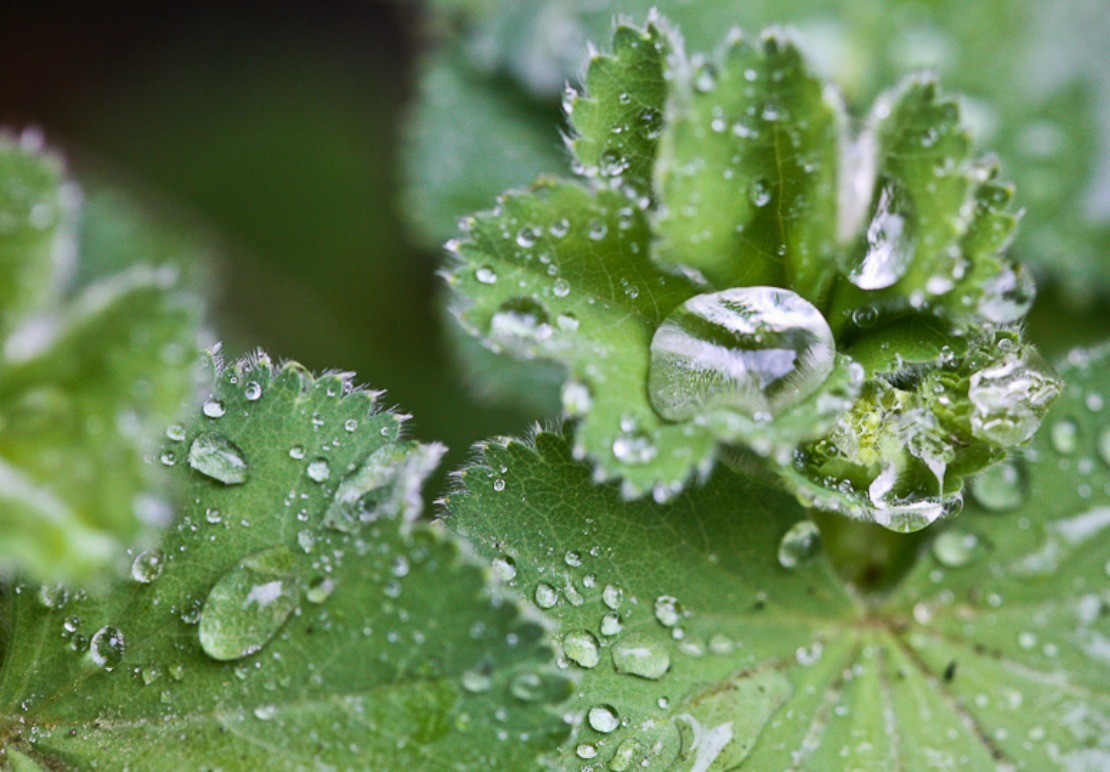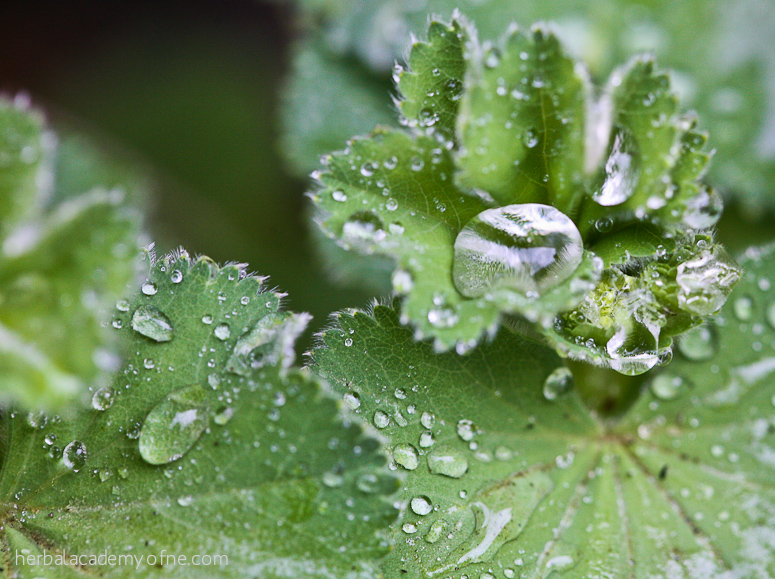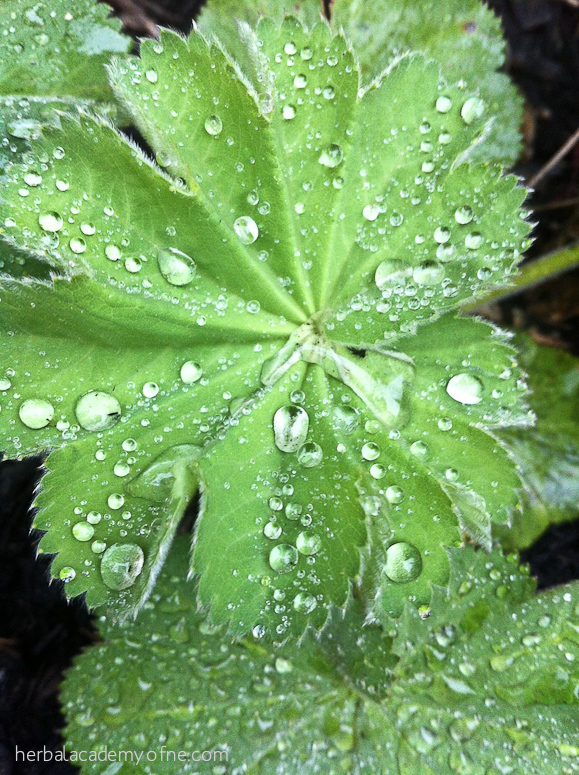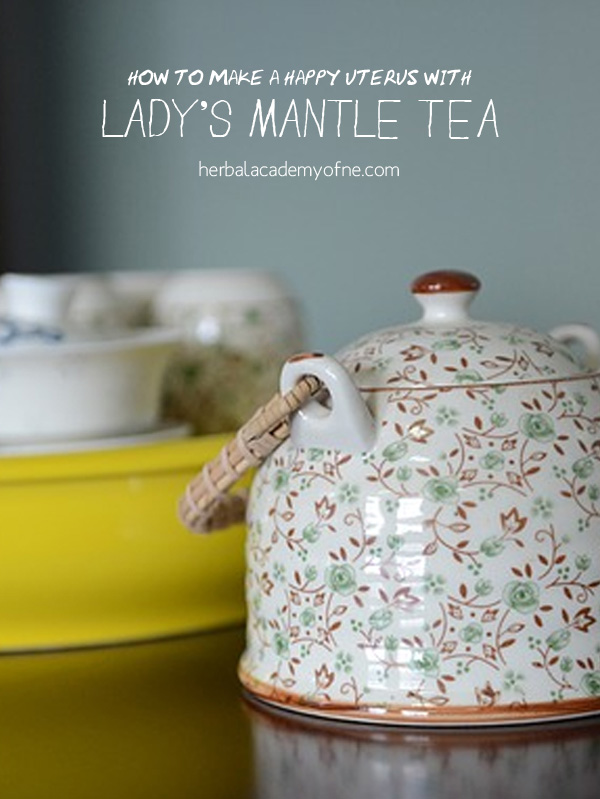
How to Make a Happy Uterus with Lady’s Mantle Tea
Lady’s mantle cups her hands to hold the morning dew. Despite her inconspicuous flowers, gardeners adore her for the dew drops, formed by a process called guttation (Roshchina, 1993), that glisten on the tips of each of her scalloped leaves and captivate even the most casual observer who strolls by. The herbalists adore her for her powerful traits to aid in healing, particularly, for women throughout their life span. The mystics have adored her for it has been understood by them that the dew drops from the lady’s mantle have mystic powers (De Bairacli Levy, 1973 and www.Star Child.co.uk). And this delicate plant makes a lovely Lady’s Mantle Tea, affectionately known as Happy Uterus Tea.
About Lady’s Mantle
A cultivated perennial, lady’s mantle is native to western and central Europe. We know one species, Alchemilla vulgaris, however there are as many as over 300 species grown in Europe. Each collects the dew in their soft leaves. Each inspires one to either taste the fresh dew or feel its wetness on one’s face. Lady’s mantle is magical in this way. Each seems to know a woman’s way.
Lady’s mantle easily grows in well-drained soil here in the U.S. in either full sun or part shade. Garden and nursery centers may sell lady’s mantle in their perennial section though it’s not nearly as popular here as in Europe. Cuttings and root divisions are the best ways to obtain a plant than trying to grow from seed (I’ve tried!).

The leaves and flowers are harvested when the flowers first begin to bloom. For teas, dry the leaves and flowers that you have harvested gently in a cool dark place. Fresh herb tea is magical. Simply take a few leaves and flowers and steep them in cool, or hot water (see below for recipes).
Uses for Lady’s Mantle
Lady’s mantle is a powerful female herb for anytime during a women’s reproductive life. It helps relieve mild aches and pains during menstruation, with a tea or tincture able to stop spotting between periods and lessening excessive menstrual bleeding (Soule, 1998). Lady’s mantle has astringent qualities so it is useful for loose stools, and shrinking sores in one’s mouth or skin (Hoffman, 2003). Lady’s mantle is also helpful for the menopausal years (Hoffman, 2003), easing those troubling symptoms due to its astringent and anti-inflammatory actions.
Deb Soule (1998) suggests that a tea of lady’s mantle and raspberry leaves taken daily for 3 weeks is helpful for a prolapsed uterus. De Bairacli Levy (1973) was well aware of lady’s mantle as a female tonic and remedy for the “organs of generation.” She writes that lady’s mantle is used to cure barrenness (infertility) and restore normal menstruation, as well as treat heart ailments and diabetes (de Bairacli Levy, 1973). Though, perhaps, left to folklore, there is still much left to say about this plant if only we continue to explore its powers!

Lady’s Mantle Tea Recipe
Here’s a recipe for “Happy Uterus Tea” to alleviate menstrual cramps. You can also use this tea at the very end of pregnancy (9th month) to prepare your uterus for labor and prevent hemorrhage. (pregnant women should always consult with their physician before taking herbs).
Happy Uterus Tea
From www.modernalternativepregnancy.com
1/2 cup lady’s mantle (we get our herbs here)
1/2 cup red raspberry leaf
1/4 cup lemon balm (you can add more to taste)
- Place all herbs in a dry, pint-size Mason jar with a lid and shake until they’re mixed up well or stir in a bowl and store in a jar. This makes enough for many cups of tea.
- To make one cup, all you need is 1 teaspoon to 1 tablespoon of mixed herbs.
- For a strong brew, steep a tablespoon of herbs in a generous cup of hot water for about 5-10 minutes and strain.
- Begin drinking the tea about a week before you are expecting your period.
- If you have problems with heavy cramping, try drinking a cup (warm or iced) every day of the month.
As a garden plant or a powerful herb; may lady’s mantle gladden your heart, refresh your soul, and nourish your body! You, too, may come to have adoration and joy for lady’s mantle, while admiring her dew-filled leaves in the morning.
This post was written by Rachel Ross of Hillside Herbals. Rachel grew up between two nature sanctuaries and received a degree in biology and a Masters in Botany. Later, she acquired an RN, and MSN, and is now a practicing Certified Nurse-Midwife. She sees the plants as powerful allies to nourish, strengthen, calm, and heal. Her humble hope is to share this knowing with you.
REFERENCES
De Bairacli Levy, Julliette (1973) Common Herbs for Natural Health. Schocken Books. New York
Hoffman, David ( 2003) Medical Herbalism; The Science and Practice of Herbal Medicine. Healing Arts Press. Rochester, Vermont.
http://www.starchild.co.uk/products/6564_3552_ladies-mantle-organic.aspx
Roshchina, V.; Roshchina, V. (1993). The excretory function of higher plants. Berlin: Springer-Verlag.
Soule, Deb (1998) A Woman’s Book of Herbs; the healing power of natural remedies. Citadel Press. New York.









